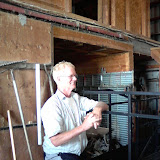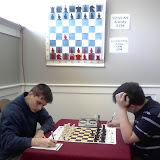
The Quebec Bridge was included in the National Transcontinental Railway project, undertaken by the federal government.
By 1904, the structure was taking shape. However, preliminary calculations made early in the planning stages were never properly checked when the design was finalized, and the actual weight of the bridge was far in excess of its carrying capacity. The dead load was too heavy. All went well until the bridge was nearing completion in the summer of 1907, when the local engineering team under Norman McLure began noticing increasing distortions of key structural members already in place.
McLure became increasingly concerned and wrote repeatedly to supervising engineer Theodore Cooper, who at first replied that the problems were minor. The Phoenix Bridge Company officials were claiming that the beams must already have been bent before they were installed, but by August 27 it had become clear to McLure that this was wrong. A more experienced engineer might have telegraphed Cooper, but McLure wrote him a letter, and then went to New York to meet with him on August 29, 1907. Cooper then agreed that the issue was serious, and promptly telegraphed to the Phoenix Bridge Company: "Add no more load to bridge till after due consideration of facts." The two engineers then went to the Phoenix offices.
But the message had not been passed on to Quebec, and now it was too late. That same afternoon, after four years of construction, the south arm and part of the central section of the bridge collapsed into the St. Lawrence River in just 15 seconds. Of the 86 workers on the bridge that day near quitting time, 75 were killed and the rest were injured. Of these victims, 33 (some sources say 35) were Mohawk steelworkers from the Kahnawake reserve near Montreal; they were buried at Kahnawake under crosses made of steel beams.[1]
It is commonly rumored that the iron and steel from the bridge collapse that could not be reused for construction was used to forge the early Iron Rings worn by Canadian Engineers starting in 1925. ( Pont de Québec )
( Pont de Québec )

By 1904, the structure was taking shape. However, preliminary calculations made early in the planning stages were never properly checked when the design was finalized, and the actual weight of the bridge was far in excess of its carrying capacity. The dead load was too heavy. All went well until the bridge was nearing completion in the summer of 1907, when the local engineering team under Norman McLure began noticing increasing distortions of key structural members already in place.
McLure became increasingly concerned and wrote repeatedly to supervising engineer Theodore Cooper, who at first replied that the problems were minor. The Phoenix Bridge Company officials were claiming that the beams must already have been bent before they were installed, but by August 27 it had become clear to McLure that this was wrong. A more experienced engineer might have telegraphed Cooper, but McLure wrote him a letter, and then went to New York to meet with him on August 29, 1907. Cooper then agreed that the issue was serious, and promptly telegraphed to the Phoenix Bridge Company: "Add no more load to bridge till after due consideration of facts." The two engineers then went to the Phoenix offices.
But the message had not been passed on to Quebec, and now it was too late. That same afternoon, after four years of construction, the south arm and part of the central section of the bridge collapsed into the St. Lawrence River in just 15 seconds. Of the 86 workers on the bridge that day near quitting time, 75 were killed and the rest were injured. Of these victims, 33 (some sources say 35) were Mohawk steelworkers from the Kahnawake reserve near Montreal; they were buried at Kahnawake under crosses made of steel beams.[1]
It is commonly rumored that the iron and steel from the bridge collapse that could not be reused for construction was used to forge the early Iron Rings worn by Canadian Engineers starting in 1925.
 ( Pont de Québec )
( Pont de Québec )1886 Gustave Eiffel est consulté sur la conception de la structure.
2 octobre 1900. Cérémonie marquant le début de la construction du premier pont.
Juin 1901. Début des travaux
29 août 1907. Première catastrophe fait 76 victimes. De ce nombre, on compte 26 Canadiens, 33 Amérindiens de Caughnowaga et 17 Américains. Le plus jeune ouvrier a 14 ans et le plus âgé, 48 ans.
Printemps 1910. Début de la construction du deuxième pont qui comprendra deux voies ferrées et deux trottoirs.
À l'aube du 11 septembre 1916.
La travée centrale du pont dont le poids est de 5 200 tonnes est engloutie dans le fleuve - 13 morts.
20 septembre 1917. Le pont de Québec est terminé.
L'inauguration officielle du pont est faite par le prince de Galles, futur Édouard VIII le 22 août 1919 .
Le plus long pont cantilever au monde.
///The Quebec Bridge is a riveted steel truss structure and is 987 metres (3,239 ft) long, 29 m (94 ft) wide, and 104 m (340 ft) high. Cantilever arms 177 m (580 ft) long support a 195 m (640 ft) central structure, for a total span of 549 m (1800 ft), the longest cantilever bridge span in the world. It is the easternmost (furthest downstream) complete crossing of the Saint Lawrence.

























Aucun commentaire:
Enregistrer un commentaire